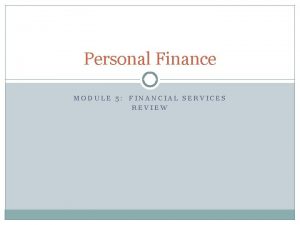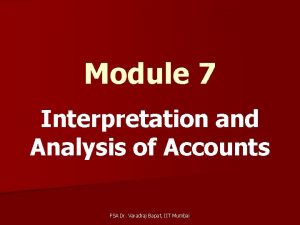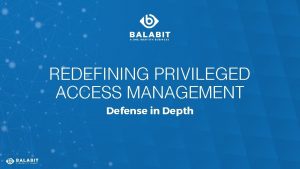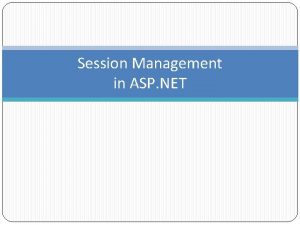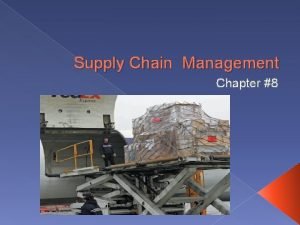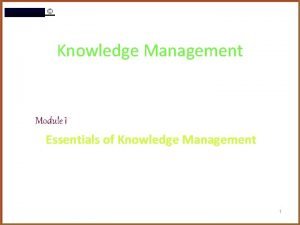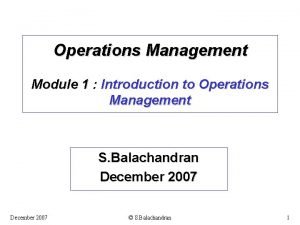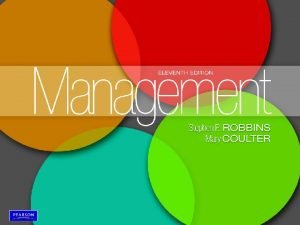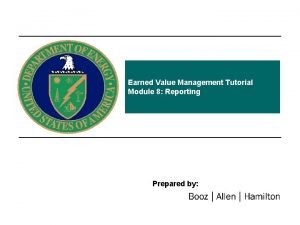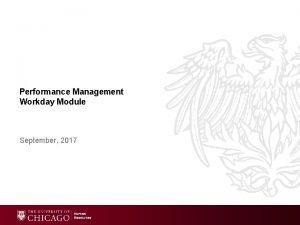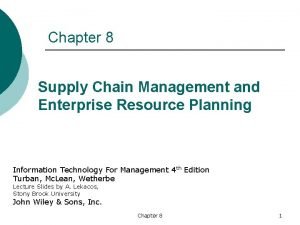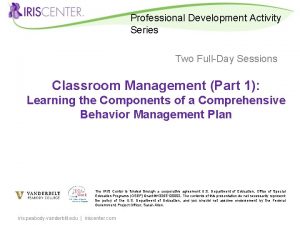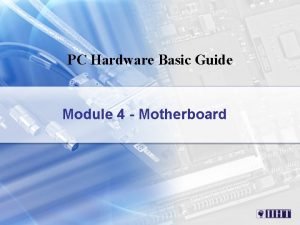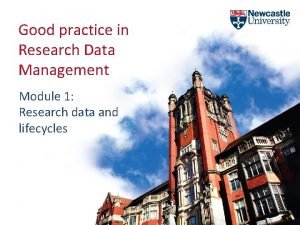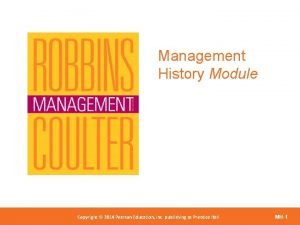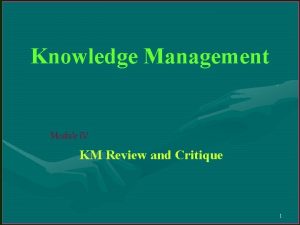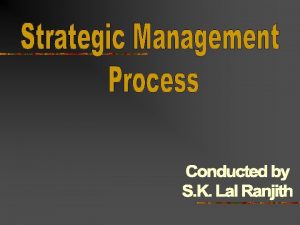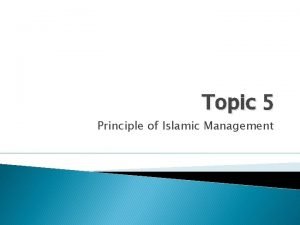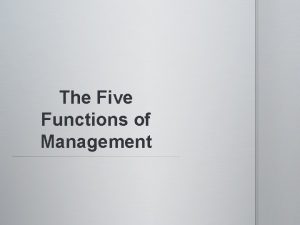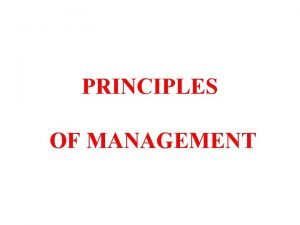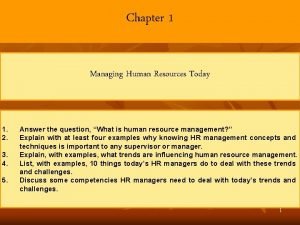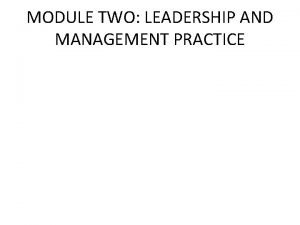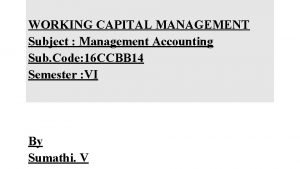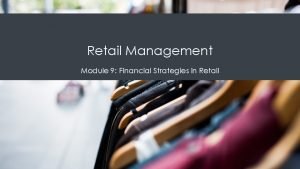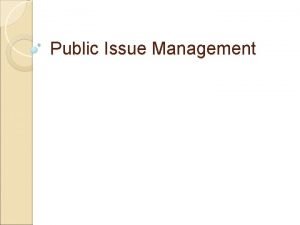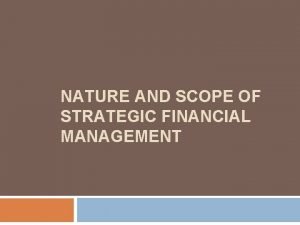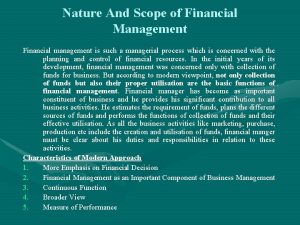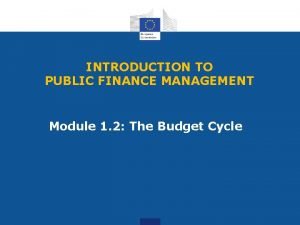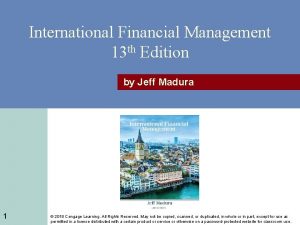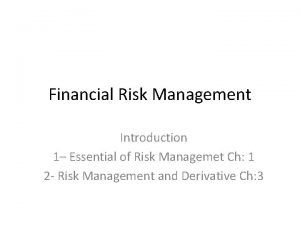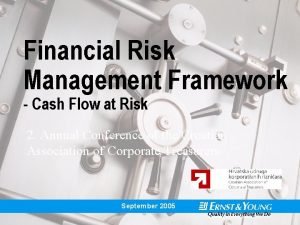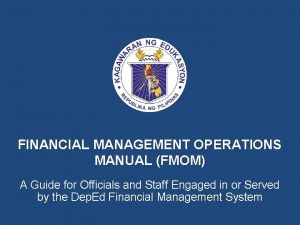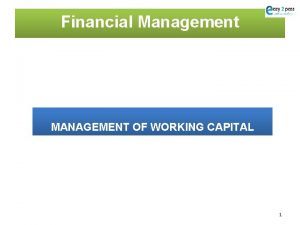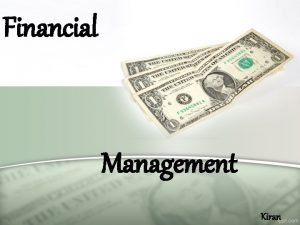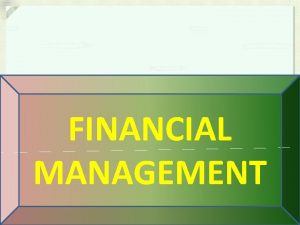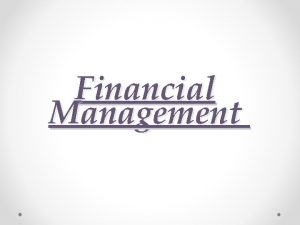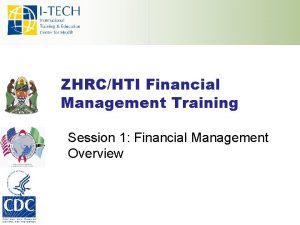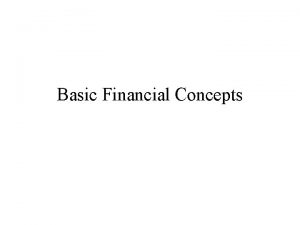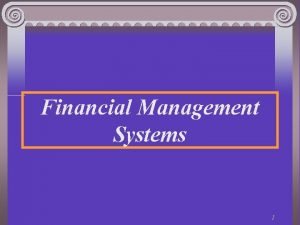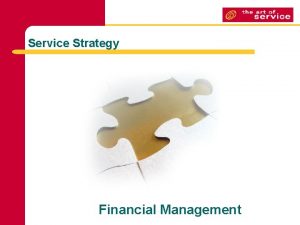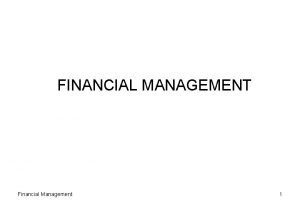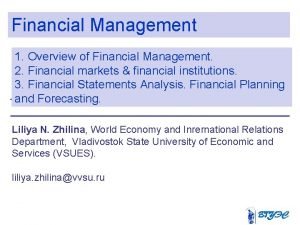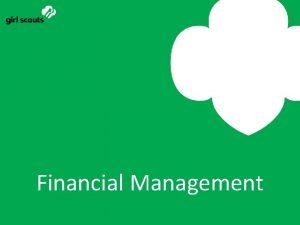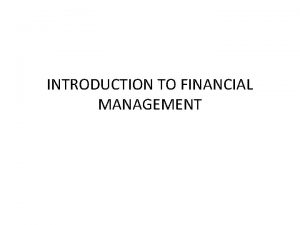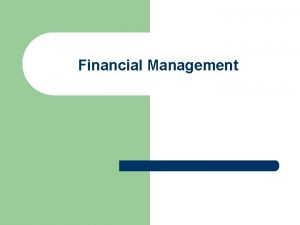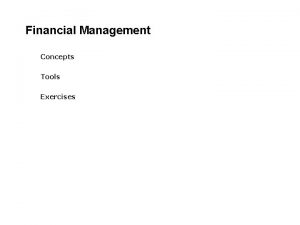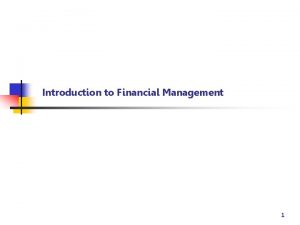Session 11 Module Five Financial Management Session 11
















































- Slides: 48

Session 11, Module Five: Financial Management

Session 11, Module Five: Financial Management • Chapter 20: Financial Decisions and Management • Questions and review suggestions v 4. 0 © 2013 Association for Financial Professionals. All rights reserved. Session 11: Module 5, Overview - 2

Chapter 20: Financial Decisions and Management Outline: • Capital Structure of a Company • Raising and Managing Long-Term Capital • Cost of Capital and Firm Value • Lease Financing and Management • Equity Financing and Management • Other Topics in Financial Decisions v 4. 0 © 2013 Association for Financial Professionals. All rights reserved. Session 11: Module 5, Chapter 20 - 3

Capital Structure of a Company • Optimal and target capital structures • Trade-offs between financing with long-term debt and common stock • Capital structure theory • Trade-off theory • Business and financial risk • Operating risk and operating leverage • Financial risk and financial leverage • Target capital structure v 4. 0 © 2013 Association for Financial Professionals. All rights reserved. Session 11: Module 5, Chapter 20 - 4

Optimal and Target Capital Structures Optimal Long. Term Debt WACC Equity Target CFOs and treasurers must factor in: • Company’s operating risks • Immediate and longterm financing needs • Relative costs of debt/equity at time funds raised • Risk-taking attitude of board and management v 4. 0 © 2013 Association for Financial Professionals. All rights reserved. Session 11: Module 5, Chapter 20 - 5

Debt Financing Advantages • Costs less than equity • Fixed or floating • Efficient capital markets for L/T debt • Earnings undiluted • Debt owners do not vote Disadvantages • Priority claim over equity • Inability to service debt bankruptcy • Increases risk and can increase WACC • Liens limit flexibility • Monitoring requirements v 4. 0 © 2013 Association for Financial Professionals. All rights reserved. Session 11: Module 5, Chapter 20 - 6

Common Stock Financing Advantages • No obligation of fixed payments to investors • Does not mature • Cushion against creditor losses • Given bright future, raise equity on attractive terms Disadvantages • Dilute voting rights, control and value? • Significant cost of underwriting • Unlike debt, no tax shield • Erode stock price? v 4. 0 © 2013 Association for Financial Professionals. All rights reserved. Session 11: Module 5, Chapter 20 - 7

Capital Structure Theory: Trade-Off Theory • Companies “trade off” use of debt and equity in capital structures. • As debt is substituted for equity, overall WACC: • At first decreases as debt is increased. • Then rises as more debt is added. • Mix of debt and equity with lowest WACC is optimal capital structure. • Real-world factors. v 4. 0 © 2013 Association for Financial Professionals. All rights reserved. Session 11: Module 5, Chapter 20 - 8

Discussion Question What is the difference between operating leverage and financial leverage? a) Operating leverage is the result of total costs in operations b) Financial leverage magnifies the impact of changes in sales on EBIT. c) Financial leverage results from fixed financing costs (interest) d) Operating leverage magnifies the results of changes in EBIT on net income. Answer: c (p. 5 -98) v 4. 0 © 2013 Association for Financial Professionals. All rights reserved. Session 11: Module 5, Chapter 20 - 9

Degree of Operating Leverage (DOL) • Operating profit responsiveness to changes in sales. • Example: Sales increase 20% but operating profit increases 33% because fixed costs stay at $2, 000. • % change in EBIT is 1. 65 times % change in sales. • Proportionately EBIT is 1. 65 times as volatile as sales. • If sales decline, EBIT declines proportionately faster. v 4. 0 © 2013 Association for Financial Professionals. All rights reserved. Session 11: Module 5, Chapter 20 - 10

Degree of Financial Leverage (DFL) • More debt in capital structure = higher interest. • Larger fixed interest expense net income more volatile as operating income changes. • Example: 33% increase in EBIT, 50% increase in net income. • Net income increases 1. 515 times as fast as EBIT. • If EBIT declines, net income declines proportionately faster. v 4. 0 © 2013 Association for Financial Professionals. All rights reserved. Session 11: Module 5, Chapter 20 - 11

Discussion Question Which is true of the DOL and DFL relationship? a) A firm with high operating leverage can tolerate more financial leverage than a firm with low operating leverage. b) Operating and financial leverage are unrelated. c) Agricultural operations with high variable costs and low fixed costs can have proportionately more debt than manufacturers with large investments in equipment. d) Large investments in equipment tend to result in low fixed costs. Answer: c (p. 5 -100) v 4. 0 © 2013 Association for Financial Professionals. All rights reserved. Session 11: Module 5, Chapter 20 - 12

Target Capital Structure: Impact of… Asset structure Business risk • Composition of assets varies by industry. • Stability of cash flows for debt payment. Shareholder control • New equity dilutes control. Profitability • Use of retained earnings for growth. Market conditions • Relative advantage of debt or equity. v 4. 0 © 2013 Association for Financial Professionals. All rights reserved. Session 11: Module 5, Chapter 20 - 13

Determine Target Capital Structure Example: A company’s “target” is between 40% and 60% debt. 40% 60% 100% equity, 0% debt 0% equity, 100% debt Debt Equity Significant debt capacity Little debt capacity High profitability High growth (large capital expenditures) Markets v 4. 0 © 2013 Association for Financial Professionals. All rights reserved. Session 11: Module 5, Chapter 20 - 14

Capital Structure Decision Considerations • Rating agencies and lenders • Limits actions to comply with covenants • Scrutinize ratings triggers • Issue of control • Too much equity risks takeover • Too much debt risks bankruptcy • Regulatory restrictions and minimum capital requirements v 4. 0 © 2013 Association for Financial Professionals. All rights reserved. Session 11: Module 5, Chapter 20 - 15

Private Placement Over Public Issuance • Less-restrictive covenants • Relatively small issue size • Reduced time to issuance • Minimal reporting, agency ratings or public disclosure • Lower costs • Control over who holds the debt • Flexibility of terms and maturities v 4. 0 © 2013 Association for Financial Professionals. All rights reserved. Session 11: Module 5, Chapter 20 - 16

Discussion Question What is the main advantage of public offerings? a) Access to capital markets has potential to raise large amounts of debt and equity at going rate. b) Low cost in managing the reporting, disclosure and rating agency requirements. c) Low cost of filing 10 -Ks, 8 -Ks, and 10 -Qs for US companies. d) Access to capital at a consistent price regardless of economic environment, technologies, industry issues, government regulations and public perceptions. Answer: a (p. 5 -107) v 4. 0 © 2013 Association for Financial Professionals. All rights reserved. Session 11: Module 5, Chapter 20 - 17

Managing Outstanding Capital Legal Manage trustee relationships Payment Disbursing agent for • Shareholder payments (common and preferred dividends as declared) • Bondholder payments (interest and principal) Investor relations • “Road shows” • Maintain shareholder lists • Send out financial statements, annual reports and other required filings • Communicate with shareholders and bondholders • Address investors’ questions v 4. 0 © 2013 Association for Financial Professionals. All rights reserved. Session 11: Module 5, Chapter 20 - 18

Cost of Debt • Interest on a bond over its life = yield to maturity (YTM). • After-tax cost of debt: interest payments are expense for tax purposes. • Example: Marginal tax rate of 30% and YTM of 5% on newly issued debt. Where: v 4. 0 © 2013 Association for Financial Professionals. All rights reserved. Session 11: Module 5, Chapter 20 - 19

Discussion Question Which technique can be used to raise common equity? a) b) c) d) Retain earnings during the period. Repurchase common stock. Pay all excess earnings out in dividends. Change the company’s beta value. Answer: a (the other method is to issue new common stock. ) (p. 5 -110) v 4. 0 © 2013 Association for Financial Professionals. All rights reserved. Session 11: Module 5, Chapter 20 - 20

Cost of Common Equity • CAPM can estimate the market’s required rate of return on equity. • Example: r. RF = 0. 04, r. M = 0. 10 and β = 1. 2. Where: v 4. 0 © 2013 Association for Financial Professionals. All rights reserved. Session 11: Module 5, Chapter 20 - 21

Weighted Average Cost of Capital (WACC) • Weighted average of cost of funds for company • Using cost of debt and equity in prior slides: Where: v 4. 0 © 2013 Association for Financial Professionals. All rights reserved. Session 11: Module 5, Chapter 20 - 22

Firm Value • Economic value added (EVA): rate of return on assets that exceeds cost of capital to create shareholder value. • Example: $50, 000 of capital employed, operating profit of $6, 800, 000 and WACC is 8. 64%. v 4. 0 © 2013 Association for Financial Professionals. All rights reserved. Session 11: Module 5, Chapter 20 - 23

Lease Financing and Management • Capital acquisition process: • Acquisition (capital budget decision prior to leasing decision) • Finance (borrowing or leasing) • Lessor receives lease payments from lessee; both get a tax benefit • Direct substitute for debt • For high uncertainty for future demand • For items outside firm’s area of expertise v 4. 0 © 2013 Association for Financial Professionals. All rights reserved. Session 11: Module 5, Chapter 20 - 24

Primary Differences Among Leases • Length of lease period • Party responsible for maintenance and upkeep • Residual value of asset • Relevant tax treatment (significant for nonprofits and municipalities) • Who retains assets at end of lease and under what terms v 4. 0 © 2013 Association for Financial Professionals. All rights reserved. Session 11: Module 5, Chapter 20 - 25

Types of Leases • Sale and leaseback • Capital or financial leases • Cash infusion • Alternative to borrowing to buy • If cannot use depreciation tax benefits • Residual value is • Operating or service leases • Lessor maintains, retains asset at end • Often OBSA • Shorter duration than asset life v 4. 0 © 2013 Association for Financial Professionals. All rights reserved. estimated value at lease end (lessee maintains, pays taxes, insurance) • Double-net lease (triplenet in real estate) • Topic 840 -10 -15: restate balance sheet (leased asset as fixed asset, lease payments as liability) Session 11: Module 5, Chapter 20 - 26

Capital or Financial Leases (ASC 840 -10 -15) Leases meeting any one of the following four conditions must be classified as a capital lease: • The length of the lease is at least 75% of the estimated useful life of the asset. • There is a transfer of ownership to the lessee at the end of the lease. • The lease agreement contains a provision that allows the lessee to purchase the asset per a bargain purchase option during or at the end of the lease’s life. • The present value of the discounted lease payments at the beginning of the lease term exceeds 90% of the asset’s fair market value. v 4. 0 © 2013 Association for Financial Professionals. All rights reserved. Session 11: Module 5, Chapter 20 - 27

Discussion Question Why do treasury professionals track estimated residual value for a leased asset and ensure proper maintenance? a) Residual value is built in to most lease arrangements, and potentially high residual value can increase lease payments. b) Lease may require payment of the difference between assumed and book residual value (mileage/condition). c) Lessee has primary claim on asset’s residual value. d) Residual value may impact lease’s tax status and OBSA listing requirements. Answer: d (p. 5 -118) v 4. 0 © 2013 Association for Financial Professionals. All rights reserved. Session 11: Module 5, Chapter 20 - 28

Lease Versus Borrow-and-Buy Decision • Costs of leasing versus costs of borrowing to buy asset • NPV of cash flows for each alternative v 4. 0 © 2013 Association for Financial Professionals. All rights reserved. Session 11: Module 5, Chapter 20 - 29

Advantages, Disadvantages of Going Public Advantages • Diversification and increased liquidity • Readily determined market value and stock price • Spin off a subsidiary Disadvantages • Regulatory disclosure • Loss of managerial flexibility • Surrender of some control • Other factors: • Smaller company stocks not especially liquid • Small market/infrequent trading undervalued stock • Increased reporting and disclosure (debt rating) v 4. 0 © 2013 Association for Financial Professionals. All rights reserved. Session 11: Module 5, Chapter 20 - 30

The Decision to List Stock Advantages Disadvantages • Increased marketability. • Added requirements keep some companies • Public exposure in OTC market. causes higher sales. • More disclosure may • OTC is liquid. lower WACC on • Some smaller company’s common companies voluntarily stock and bonds, delist rather than increasing firm’s market value. comply with NYSE requirements v 4. 0 © 2013 Association for Financial Professionals. All rights reserved. Session 11: Module 5, Chapter 20 - 31

Shareholder Rights Control of company Cumulative voting Proxy Staggered election of directors Preemptive right v 4. 0 © 2013 Association for Financial Professionals. All rights reserved. Session 11: Module 5, Chapter 20 - 32

Mergers and Acquisitions • Merger by agreement or to make takeover palatable • Acquisition: Friendly or hostile • Friendly: Bidder informs board of intent • If rejected, take case directly to shareholders • Hostile methods: • Tender offer • Proxy fight • Creeping tender offer • Hostile: less chance for due diligence v 4. 0 © 2013 Association for Financial Professionals. All rights reserved. Session 11: Module 5, Chapter 20 - 33

Leveraged Buyout (LBO) Acquirer Acquired High debt for purchase Uses junk debt Can sell in pieces Takes private v 4. 0 © 2013 Association for Financial Professionals. All rights reserved. Repayments Balance sheet Operating funds Higher risk Session 11: Module 5, Chapter 20 - 34

Financing the Transaction • All-cash • Stock • Mixed stock/cash • Leveraged buyout • Debt • Mixed cash/debt • Preferred stock v 4. 0 © 2013 Association for Financial Professionals. All rights reserved. Session 11: Module 5, Chapter 20 - 35

Discussion Question Cash for acquiring a firm can come from all of the following EXCEPT? a) Cash from the acquiring company b) Excess cash from the acquired company c) Cash from the sale of some of the acquired firm’s assets d) Issuance of investment-grade bonds that have an amortization schedule supported by a forecast of operating cash flows e) Issuance of below-investment-grade bonds with no amortization schedule Answer: e (the amortization schedule in d is needed for item e) (p. 5 -130) v 4. 0 © 2013 Association for Financial Professionals. All rights reserved. Session 11: Module 5, Chapter 20 - 36

Tax Strategies • Global tax strategy to avoid unfavorable taxation: • Double taxes • Balancing home and foreign tax considerations • Countries without international tax treaties • Widespread, complex international transfer pricing: • Strict arm’s length • Both home country and foreign transfer rules • Deemed dividends • Solid tax strategy requires understanding firm’s: • Business and financial position • International operating strategy • Intended countries of operation v 4. 0 © 2013 Association for Financial Professionals. All rights reserved. Session 11: Module 5, Chapter 20 - 37

Dividend Policy Capital Structure • Steadily increasing dividend attracts certain institutional investors • Increasing dividends reduces cash flow and therefore growth Optimal Policy • Maximizes shareholder value • Retains sufficient profits to fund asset expansion • Distributes appropriate income to shareholders • “Signaling” v 4. 0 © 2013 Association for Financial Professionals. All rights reserved. Session 11: Module 5, Chapter 20 - 38

Dividend Payment Procedures Date Definition Declaration date Date board declares dividend Record date Date specified by board when holders-ofrecord are entitled to receive declared dividend Ex-dividend date Date stock is sold without dividend entitlement (two days prior to holder-ofrecord date) Payment date Date dividend is paid v 4. 0 © 2013 Association for Financial Professionals. All rights reserved. Session 11: Module 5, Chapter 20 - 39

Dividend Reinvestment Plans (DRIPs) • To increase share ownership • Existing shareholders purchase shares: • Directly from company • On when-desired basis • Normally no commission • Can automatically reinvest dividends in additional shares • Shares distributed under DRIPs may be: • Held in the treasury • Repurchased by the company in the market • New, authorized shares of shelf registered stock • Benefits smaller shareholders v 4. 0 © 2013 Association for Financial Professionals. All rights reserved. Session 11: Module 5, Chapter 20 - 40

Different Types of Dividends Cash dividends Stock dividends Special dividends Liquidating dividends Stock splits v 4. 0 © 2013 Association for Financial Professionals. All rights reserved. Session 11: Module 5, Chapter 20 - 41

Discussion Question Which is an important means of returning capital to shareholders that can be used as an alternative to paying cash dividends? a) b) c) d) Stock splits Special dividends Stock repurchases Intracompany dividends Answer: c (p. 5 -136) v 4. 0 © 2013 Association for Financial Professionals. All rights reserved. Session 11: Module 5, Chapter 20 - 42

Intracompany Dividends, Dividend Taxes Intracompany dividends Taxes on dividends • Transfer of profits from subsidiary to parent • Stated percentage • Thin capitalization • Taxes or regulatory restrictions • Covenant impact • Cross-border scrutiny • Mainly impact recipients • Taxable income • May be taxed at different rate than capital gains • Double taxation issues • Tax experts needed v 4. 0 © 2013 Association for Financial Professionals. All rights reserved. Session 11: Module 5, Chapter 20 - 43

Repatriation of Capital by MNCs • Foreign subsidiary pays dividends to parent. • Governments often act to restrict repatriation of capital, e. g. , dividends. • MNCs unbundle subsidiary cash flows; easier to justify to governments than dividends: • Management fees • Transfer pricing • Intracompany loans v 4. 0 © 2013 Association for Financial Professionals. All rights reserved. Session 11: Module 5, Chapter 20 - 44

Discussion Question Section 956 of the U. S. tax code requires a U. S. shareholder of an OFC of a U. S. MNC to currently include in income its pro rata share of any increase in the earnings of the OFC that are invested in U. S. property. This is a a) b) c) d) transfer pricing issue. deemed dividend issue. intracompany loan issue. restriction on dividend issue. Answer: b (p. 5 -139) v 4. 0 © 2013 Association for Financial Professionals. All rights reserved. Session 11: Module 5, Chapter 20 - 45

Discussion Question Which is another primary use for market analysis and research tools? • Portfolio investment decisions (i. e. , when purchasing/selling investments or managing the portfolio) • Acquisition and divestment decisions • Comparisons with other companies or industry averages a) Stock repurchase decisions b) Evaluating trading partners for credit and counterparty risk c) Evaluating when to delist stock d) Stock split decisions Answer (p. 5 -140): b v 4. 0 © 2013 Association for Financial Professionals. All rights reserved. Session 11: Module 5, Chapter 20 - 46

Questions and Review Suggestions • Questions? • Suggestions for subjects to review in next session? • For next session: • In class case study? • Take home case study and in -class practice exam? v 4. 0 © 2013 Association for Financial Professionals. All rights reserved. Session 11: Questions/Review - 47

End of Session 11 Assignment: • Take the online post-test. • Review your online individual reports for areas with lower test scores: • Review the selected chapters. • Review the test-your-understanding questions at the end of these chapters. • Review the online module flashcards. • Retake selected online calculations. • Retake selected online module-specific tests. • Review selected Exam Practice (Describe and Differentiate) questions (located at the end of each module textbook). • Come prepared with questions on the entire course. • Options: case study and/or in-class practice exam. v 4. 0 © 2013 Association for Financial Professionals. All rights reserved. Session 11: Questions/Review - 48
 C device module module 1
C device module module 1 And now with gleams of half-extinguished thought
And now with gleams of half-extinguished thought One in five challenge
One in five challenge 5 elements and 5 senses
5 elements and 5 senses Dew the sovereign flower and drown the weeds
Dew the sovereign flower and drown the weeds Personal finance module
Personal finance module Module 7 financial statement analysis
Module 7 financial statement analysis Financial methods of motivation
Financial methods of motivation Balabit pricing
Balabit pricing Session tracking in asp.net
Session tracking in asp.net Draw a layout of your production area
Draw a layout of your production area Order promising module of supply chain management
Order promising module of supply chain management Pricing strategies in retail management
Pricing strategies in retail management Knowledge management module
Knowledge management module Introduction to operations management module
Introduction to operations management module Management history module
Management history module Earned value management tutorial
Earned value management tutorial Workday performance management module
Workday performance management module Chapter8 enterprice recource planning
Chapter8 enterprice recource planning Iris module classroom management
Iris module classroom management Workday performance management
Workday performance management Module 4 topic 2 components of the space management system
Module 4 topic 2 components of the space management system Module 4 operating systems and file management
Module 4 operating systems and file management Data management module
Data management module Management history module
Management history module Knowledge management module
Knowledge management module Top management middle management first line management
Top management middle management first line management Management pyramid
Management pyramid Top management and middle management
Top management and middle management Five tasks of strategic management
Five tasks of strategic management Five 5 principles of islamic management
Five 5 principles of islamic management 5 functions of management
5 functions of management Five functions of management
Five functions of management Human resources today
Human resources today Steps involved in portfolio management
Steps involved in portfolio management Five management practice
Five management practice Accounting subject code
Accounting subject code Financial strategy in retail management
Financial strategy in retail management What is public issue management mean
What is public issue management mean Strategic financial management definition
Strategic financial management definition Explain scope of financial management
Explain scope of financial management Daibb management accounting question solution
Daibb management accounting question solution Six phases of public financial management
Six phases of public financial management International financial management 13th edition
International financial management 13th edition Risk management irrelevance proposition
Risk management irrelevance proposition Financial risk management framework
Financial risk management framework Deped gov ph financial management operations manual
Deped gov ph financial management operations manual What is working capital in financial management
What is working capital in financial management Meaning of financial management
Meaning of financial management





